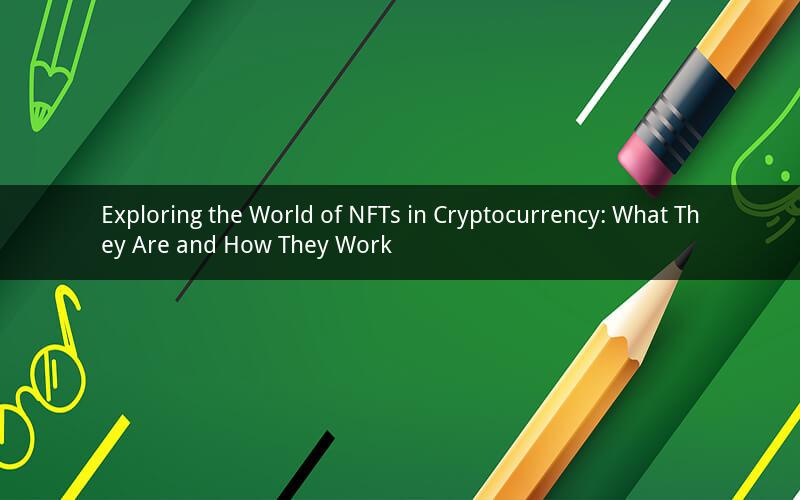
Introduction:
In recent years, the rise of non-fungible tokens (NFTs) has sparked a significant interest in the cryptocurrency world. These unique digital assets have revolutionized the way we perceive ownership and value in the digital realm. But what exactly are NFTs, and how do they work? Let's delve into the fascinating world of NFTs in cryptocurrency.
Understanding NFTs:
1. Definition:
An NFT is a digital asset that represents ownership or proof of authenticity of a unique item. Unlike cryptocurrencies like Bitcoin or Ethereum, which are fungible and can be exchanged on a one-to-one basis, NFTs are non-fungible, meaning each token is distinct and cannot be interchanged with others.
2. Blockchain Technology:
NFTs are built on blockchain technology, primarily using smart contracts. A blockchain is a decentralized ledger that records transactions across multiple computers. Smart contracts are self-executing contracts with the terms of the agreement directly written into code.
3. Unique Identification:
Each NFT is assigned a unique identifier, usually a token ID, which distinguishes it from other tokens. This unique identification is crucial in ensuring the authenticity and ownership of the digital asset.
4. Digital Ownership:
NFTs provide a way for individuals to own digital assets in a transparent and secure manner. By purchasing an NFT, the buyer gains exclusive ownership rights over the digital item, which can be verified on the blockchain.
5. Applications of NFTs:
NFTs have found various applications across different industries, including art, music, gaming, and collectibles. Artists can tokenize their work, allowing fans to own a digital version of their creations. Similarly, musicians can release exclusive digital albums as NFTs, providing a new revenue stream.
How NFTs Work:
1. Creation:
The process of creating an NFT begins with the artist or creator. They choose a digital asset, such as an image, video, or audio file, and upload it to a platform that supports NFT creation. The platform then generates a unique token based on the chosen asset.
2. Minting:
Once the token is created, the artist or creator needs to mint it. Minting is the process of permanently recording the token on the blockchain. This process involves paying a fee, known as a gas fee, to the network.
3. Ownership Transfer:
After minting, the NFT can be transferred from one owner to another. This transfer is recorded on the blockchain, ensuring transparency and traceability. The new owner becomes the sole owner of the digital asset, with proof of ownership verified on the blockchain.
4. Verification:
NFTs can be verified using blockchain technology. By checking the token ID or using blockchain explorers, anyone can confirm the ownership and authenticity of the digital asset. This verification process adds an extra layer of trust and security.
5. Marketplaces and Exchanges:
NFTs are bought and sold on specialized marketplaces and exchanges. These platforms provide a marketplace for creators and buyers to interact, facilitating the buying and selling of NFTs. Examples of popular NFT marketplaces include OpenSea, Rarible, and Foundation.
FAQs about NFTs in Cryptocurrency:
1. Q: Can NFTs be copied or duplicated?
A: No, NFTs are designed to be unique and cannot be copied or duplicated. Each NFT has a unique token ID, ensuring its authenticity and ownership.
2. Q: How do NFTs generate revenue for creators?
A: Creators can generate revenue through various means, including selling their NFTs, licensing their digital assets, or offering exclusive experiences or benefits to NFT holders.
3. Q: Are NFTs a good investment?
A: Like any investment, NFTs come with risks. While some NFTs have experienced significant value appreciation, others may not. It is essential to conduct thorough research and consider the volatile nature of the cryptocurrency market before investing in NFTs.
4. Q: Can NFTs be used for real-world transactions?
A: Yes, NFTs can be used for real-world transactions. For example, artists can tokenize physical assets, allowing buyers to purchase and own a digital representation of the item.
5. Q: Are NFTs legal?
A: NFTs are legal in most jurisdictions, but it is crucial to comply with local regulations and laws. It is advisable to consult with legal professionals to ensure compliance when engaging in NFT-related activities.
Conclusion:
NFTs have emerged as a groundbreaking innovation in the cryptocurrency world, offering a new way to own, verify, and trade digital assets. With their unique characteristics and diverse applications, NFTs have the potential to revolutionize various industries. Understanding the fundamentals of NFTs is essential for anyone interested in exploring this exciting and rapidly evolving field.